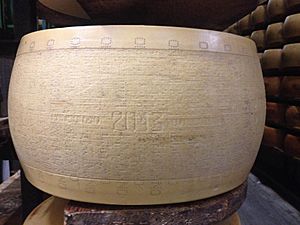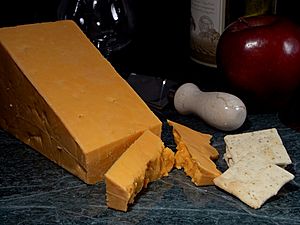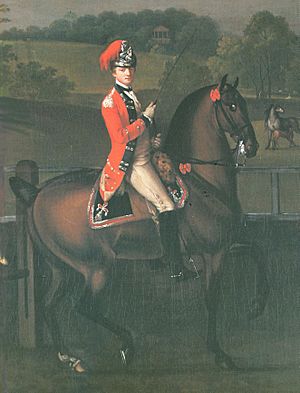Nottingham cheese riot facts for kids
The Nottingham Cheese Riot was a big event that happened on October 2, 1766. It took place at the famous Goose Fair in the city of Nottingham, England. This riot happened because people were worried about not having enough food and prices were going up.
Violence started when local people tried to stop merchants from Lincolnshire from taking away cheese they had bought. These cheeses were made in Nottinghamshire. During the riot, a warehouse, shops, and even a boat carrying goods were broken into and emptied. Hundreds of cheese wheels were rolled and thrown through the streets.
The mayor of Nottingham could not stop the riot, so the army was called in. Soldiers fired into the crowds, and one man was killed, with others getting hurt. After a few days of trouble, things finally returned to normal.
Why the Cheese Riot Happened
The Nottingham Goose Fair is a very old event, starting about 1,000 years ago. It began as a celebration for Matthew the Apostle. Over time, it became a market where many geese were sold. Later, horses were traded there too. By the 1700s, the fair was mostly known for selling food, especially tons of cheese each year. The cheese made in Nottingham back then was sold in wheels. People think it was like the cheese we know today as Red Leicester.
In 1766, the harvest was not good. This made people fear there would not be enough food. When the fair opened on October 2, there was a lot of cheese for sale. However, the prices were very high. For example, 112 pounds (about 50 kilograms) of cheese cost around £140–£180 in today's money. This was about twice the price seen in other markets just a week earlier. Because food was scarce, people wanted to keep it in their local areas. Sometimes, angry crowds even forced merchants to sell their goods at lower, older prices.
The Riot Begins
The riot started on October 2, 1766. Some merchants from Lincolnshire bought a lot of cheese. They planned to take it back to their county to sell it there. But a group of "rude lads" surrounded them. These young men demanded that the merchants not take the cheese away. They wanted the cheese to be shared in Nottingham instead.
Soon, violence broke out. People began to steal cheese everywhere. Shop windows were smashed, and hundreds of cheese wheels were thrown and rolled down streets like Wheeler Gate and Peck Lane. The mayor of Nottingham tried to stop the chaos. But he was knocked over by a rolling cheese wheel!
Some local people even got weapons. They set up roadblocks on the city streets. This was to stop merchants from carrying away any more cheese. A boat near Trent Bridge was taken over. Its cargo of cheese was stolen, even though the owner offered to pay the crowd or sell his cheese cheaply.
One warehouse was attacked. The people defending it eventually used firearms to make the crowd leave. But some cheese was still taken. The warehouse owner then gathered a group of people on horseback. They tried to find the stolen cheese, which had been taken to Castle Donington. The local judge there would not sign search warrants for houses in the village. So, the group arrested several people they thought were rioters. They also banged on the judge's house gates, demanding justice. But a crowd of women and children threw stones at them, and the group had to leave. The stolen cheese was never found.
In Nottingham, the local leaders asked for military help to bring peace back. Nottingham was a town with soldiers stationed there. So, the 15th Dragoons, along with local foot soldiers and cavalry, were sent in. Some shots were fired into the crowd. This caused injuries and led to the death of one man, William Eggleston. He was a farmer who was standing near a pile of cheese. It seems he was killed while trying to protect his own goods, but he was mistaken for someone stealing. Several people were arrested and taken to a private house. But they were set free after the angry crowd attacked the house, breaking windows to get in. The trouble continued through the night.
What Happened After the Riot
The violence in Nottingham went on for several days. Finally, the military was able to bring order back. For a while, wagons carrying cheese had to travel in groups. They were given armed guards to protect them. A local newspaper, the Leicester and Nottingham Journal, blamed the rioters for causing a cheese shortage in the city.
There were other riots in England in late 1766. These were also caused by food shortages and rising food prices. The trouble was especially bad in areas like Devon and Cornwall. But there were also serious riots in places like Gloucester, Bristol, Derby, Birmingham, and Norwich. The South East of England was mostly peaceful during this time.
In 2016, the 250th anniversary of the riot was remembered. The Lord Mayor of Nottingham, Mohammed Saghir, marked the event with a local cheese shop.
Images for kids







